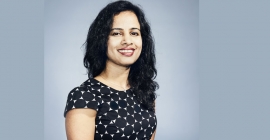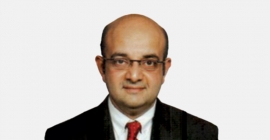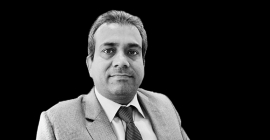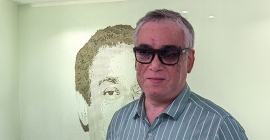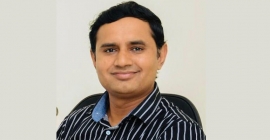‘Absolute simplicity, absolute minimalism, absolute honesty’
By Pray Jani - May 27, 2020
One or two sites here and there don’t make an impact; a threshold level of visual coverage is important, says, Abhik Sanyal, Vice President, Marketing, DSP Investment Manager
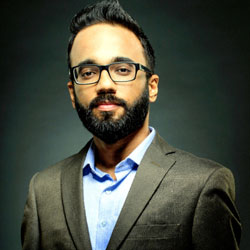 What is your brand philosophy on communicating through outdoor advertising medium?
What is your brand philosophy on communicating through outdoor advertising medium?
If you see our recent campaigns, like the ‘Markets Fluctuate’ campaign and now the ‘Bachao’ campaign, you will see that the message is such that it drives the point home very simply in the minds of our target audience. Earlier, we had tried complicated messaging but recognised the need to change.
We have also tried to use OOH to send reminders to people in the past, and we have also tried giving rational messaging. However, we realised that what drives people more is the simplest form of communication. Hence, our brand philosophy of communication when it comes to outdoor advertising is based on the cornerstones of absolute simplicity, absolute minimalism and the idea of absolute honesty. We don’t want to complicate the communication, we want to be responsible in what we are saying, but we also need to be meaningfully attractive to the people. If we are not attractive, then people will have a completely indifferent reaction to our campaign.
During the tax saving season, for example, there are so many tax saving communications that are out, so why will someone notice our message over others if we just say -- invest in tax saving funds. So, we just removed the word “tax” from our message and stuck to minimalism. We believe in converting communication to a simpler form and a very important part of that is removing the clutter. We believe in standing out from the crowd even if that means taking the road less travelled.
To be honest, it is not that difficult to stand out; all you need is the will to be different from what everyone else is doing and for you to be able to sharply identify what the central idea behind the communication to the viewer has to be. That would make your communication very precise.
Tell us something about your recent “Bachao” campaign.
We had earlier tried a three-word campaign with the ‘Axe Your Tax’ campaign. That campaign did not feature names of our products in any way. All it said was “Axe Your Tax’ and it gave a URL. So, we have been trying the concept of minimalism for a while, and “Bachao” is a simple extension of that idea where we challenged ourselves to make it shorter than three words -- to just one word.
Moreover, the ‘Axe Your Tax’ campaign was meant to push our product, whereas the ‘Bachao’ campaign is more about educating consumers about our offerings. We felt the need to do this educational campaign because we found a lot of people opting for other tax saving instruments. ELS as a category has a lot of advantages like offering market-linked investment benefits, shortest lock-in period, competitive returns and so on. Rationally, there is a big advantage in buying this product but we thought, let us make it even more simple, perhaps even strike an emotional chord. We thought, let’s not give viewers proof-points on why they should consider this category but go straight with the pure benefit, which is saving tax. Hence, the focus on just one word ‘Bachao’.
A big consideration for us was that something like this was not done before. If you’ve seen our creatives, we have not even used any images because frankly, we didn’t see a reason for adding elements just for the sake of following the traditional headline-image-copy-CTA template. If we can communicate through just one word and it stands out, there is nothing better. When it all comes together and grabs viewer attention, our job is done. And that is the primary purpose of OOH, in my opinion – to grab attention, meaningfully.
When it comes to media allocation, what are the formats that DSP Investment Manager prefer?
We don’t have a preference in terms of media options. We create a media plan depending on the message we have to give to the audience. The ‘Markets Fluctuate’ campaign, for example, was meant for a slightly advanced user. Therefore, the media allocation was for a slightly different audience. ‘Bachao’ is for everyone associated with paying tax and wanting to save. Hence, for this campaign we were looking at everything from large format billboards to frequency building BQS media, to media at corporate business parks. It was relevant to anyone with an income upwards of a certain level, where tax saving would be a relevant need.
We also look at transit media options for our communication. We took up metro train wraps, and media on buses and trains. We tend to not overuse airport media for mass campaigns. If we were to opt for airport media, we’d keep our messaging more thoughtful and showcase it tactfully, probably with a mix of media, like branding on the baggage conveyor belts, static/ dynamic backlit media, in-flight branding, etc.
Generally, the key is to take clusters. One or two sites here and there don’t make an impact so a threshold level of visual coverage is important.
You have had the experience of buying DOOH media through a programmatic platform. What were the key takeaways?
We have tried programmatic digital OOH options, but we have not gone into it in great detail. There are options available today that allow you to display the content depending on the time of day or place or type of customer. Those options are good from a frequency building perspective but slightly difficult from the monitoring perspective, especially at an overall campaign level. Of course, this is getting better and monitoring tools are also getting more organised.
Programmatic DOOH has been in place for a while now, but I see certain apprehension from brands with regard to programmatic platforms. I feel brands need to educate themselves on those channels and see the outcomes for themselves.
The way a campaign is planned and executed via pDOOH is different from the conventional way of advertising. pDOOH provides clearer feedback; and gets you a better sense of the numbers. One is able to change the campaigns and creatives instantly. Besides, DOOH has minimal production costs and one can experiment, test different messages and find out which message performs better and even change the creatives without incurring additional production costs -- which tends to be a deterrent on traditional media.
One other factor to keep in mind is that when it comes to traditional OOH, one could probably negotiate and get media through the agency or through personal relationships, but when it comes to pDOOH, the media bidding is competitive and not ‘relationship dependent’.
What is good is that agencies are also beginning to realise that efficiency, tracking and accountability is higher when it comes to pDOOH. But yes for pDOOH (or even DOOH) to work and become mainstream, what is required is a strong network and a massive increase in coverage.
When it comes to advertising, what percentage of your marketing budget goes for OOH?
We have changed the allocation to OOH over the years depending on the objectives. It depends on the kind of messaging, we follow. There are times when more than 60% went to OOH, while there are also times when it was zero. It is not that one sticks to one single channel all the time. When mass media and reach + impact are on our agenda, outdoor becomes a big part of our media mix. The ‘Markets Fluctuate’ was a pure OOH campaign while ‘Axe Your Tax’ was 80% OOH, 20% digital in terms of budget allocation.
I am not of the belief that online media is always superior to traditional formats in delivering impact. Different media options have a different purposes for brands. There is a story-telling format that TV provides, there is the ability to track and monitor that makes digital media effective and there is big impact that can created when a brand uses OOH effectively.
In my opinion, traditional media like large billboards and now newer digital OOH formats are here to stay. There is a reason why online brands like Amazon, Google or Netflix run large scale campaigns on OOH.
You have been using outdoor extensively in recent years. What challenges have you faced while launching your OOH campaigns?
Fragmented media ownership poses a big challenge. It is bit of a black box eventually, especially when you are doing a big campaign. When it comes to small campaigns, it is easier to monitor; it is easier to locate the media owners and you know what kind of a deal can be expected from a smaller set of media owners. But when a big campaign is to be executed with a budget of Rs 3-5 crore, targeting thousands of touchpoints, how can a brand be sure that all or most of those touchpoints are properly targeted? Monitoring systems are agency specific and there is always a problem of believability in terms of campaign tracking and effectiveness monitoring. This is especially true when it comes to innovations.
When it comes to print, we know the costs exactly. In OOH, there is generally no transparent rate-card. One agency could give you a site for Rs 10 lakh while another would give the same site for Rs 5 lakh. When one approaches media owners directly, the rates can be higher or lower than when one goes through an agency. Also, while some agencies are good at large format media and therefore evangelise only those formats, others may be good with digital OOH. So, how does one institutionalise a transparent rate-card or bidding system in the OOH industry?
Outdoor is constantly growing and newer media are coming into the market (like cab top media, ‘bike’ media and what not); some work needs to be done in that direction as well. How effectively can OOH work in tandem with activation?
And finally, the problem of high production costs remains. DOOH solves that issue in a way, but how do brands change creatives when it comes to longer-term OOH plans, without the need to incur big costs for creative refreshes?
What changes do you anticipate in the OOH industry in the coming times?
I believe OOH will increasingly go the digital way in the coming years. Perhaps more and more OOH agencies will need in-house digital expertise– such that they can evangelise a mix of both those mediums. The efficiency and accountability through this combination will be very high, and will also enable brands to track every single campaign smartly.

Stay on top of OOH media trends

